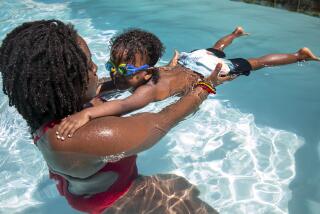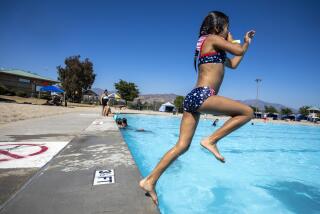Preventing Drownings
- Share via
While plant safety can prevent a number of needless injuries and poisonings, experts agree that the swimming pool is a greater danger to young children. In Southern California, drownings are the No. 1 cause of deaths for children between 1 and 4 years old.
Here are some tips to prevent drownings:
--Buy and use an automatic pool cover. Automatic covers are recommended because they are more likely to be used consistently. Pool covers should be able to support the weight of an adult and fasten securely in place.
--Do not use floating pool covers. They can trap and conceal a child who gets underneath it.
--Spas should also be covered when not in use. Like pool covers, spa covers are only effective if they are used consistently and fastened securely.
--Drain standing water from pool or spa covers.
--Install a five-foot fence, which is difficult for children to climb, to separate the pool or spa from the residence. Children should not be able to squeeze through any spaces. While most local codes specify fencing and gates around the exterior of property with pools, there are no specific requirements for fencing within the back yard. Internal fencing, however, is an important step to protect youngsters from drowning.
--Gates and doors leading to the pool or spa area should be self-closing and self-latching with latches above a child’s reach. Gates should open away from the pool.
--Remove from the pool area chairs that children could use to climb over fences and gates.
--Pay attention to the design of the pool itself. The design should not have any protruding corners where children could bump their heads while swimming or, especially, while diving.
--The surface around the pool should be rough or textured to avoid slipping.
--Don’t leave toys in the pool or spa area.
--Children should never be allowed to enter the pool (or spa) area without adult supervision. The supervising adult should know how to swim.
--Do not rely on swimming lessons, water wings, inner tubes or other devices as a substitute for constant supervision.
--Maintain constant visual contact with children in the pool or spa area. Drownings can often occur quickly and without an audible warning, even when adults were nearby.
--If your child is missing, check the water first.
--Anyone over 14 years old should learn CPR and update their skill every year.
--Keep rescue equipment by the pool.
--Have an accessible telephone by the pool or spa area for emergencies.
--Caution should also be applied when small children are around decorative ponds, fountains, and even large puddles or buckets of water. Toddlers can drown in as little as two inches of water.
Sources: Children’s Hospital of San Diego and landscape architect Nick Martin.
More to Read
Sign up for Essential California
The most important California stories and recommendations in your inbox every morning.
You may occasionally receive promotional content from the Los Angeles Times.













![Vista, California-Apri 2, 2025-Hours after undergoing dental surgery a 9-year-old girl was found unresponsive in her home, officials are investigating what caused her death. On March 18, Silvanna Moreno was placed under anesthesia for a dental surgery at Dreamtime Dentistry, a dental facility that "strive[s] to be the premier office for sedation dentistry in Vitsa, CA. (Google Maps)](https://ca-times.brightspotcdn.com/dims4/default/07a58b2/2147483647/strip/true/crop/2016x1344+29+0/resize/840x560!/quality/75/?url=https%3A%2F%2Fcalifornia-times-brightspot.s3.amazonaws.com%2F78%2Ffd%2F9bbf9b62489fa209f9c67df2e472%2Fla-me-dreamtime-dentist-01.jpg)